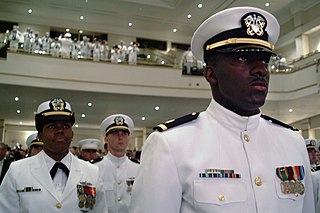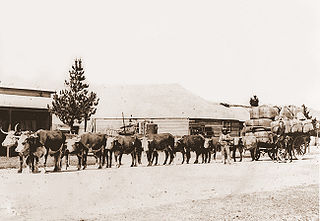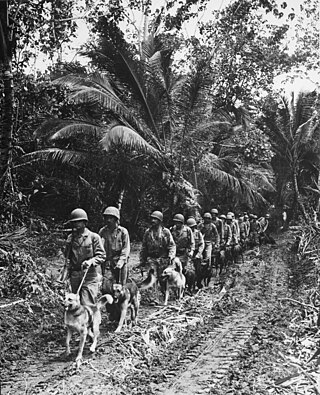Related Research Articles

The Akita is a Japanese dog breed of large size. Originating from the mountains of northern Japan, the Akita has a short double coat similar to that of many other northern spitz breeds. Historically, they were used by matagi for guarding and the hunting of bears.

The German Shepherd, also known in Britain as an Alsatian, is a German breed of working dog of medium to large size. The breed was developed by Max von Stephanitz using various traditional German herding dogs from 1899.

The Reserve Officers' Training Corps is a group of college- and university-based officer-training programs for training commissioned officers of the United States Armed Forces.

Lackland Air Force Base is a United States Air Force (USAF) base located in Bexar County, Texas, United States. The base is under the jurisdiction of the 802d Mission Support Group, Air Education and Training Command (AETC) and an enclave of the city of San Antonio. It is the only site for USAF and United States Space Force enlisted Basic Military Training (BMT).

A therapy dog is a dog that is trained to provide affection, comfort and support to people, often in settings such as hospitals, retirement homes, nursing homes, schools, libraries, hospices, or disaster areas. In contrast to assistance dogs, which are trained to assist specific patients with their day-to-day physical needs, therapy dogs are trained to interact with all kinds of people, not just their handlers.

The United States Coast Guard Reserve is the reserve component of the United States Coast Guard. It is organized, trained, administered, and supplied under the direction of the Commandant of the Coast Guard through the Assistant Commandant for Reserve (CG-R).

The United States Army Reserve (USAR) is a reserve force of the United States Army. Together, the Army Reserve and the Army National Guard constitute the Army element of the reserve components of the United States Armed Forces.

The United States Navy Reserve (USNR), known as the United States Naval Reserve from 1915 to 2005, is the Reserve Component (RC) of the United States Navy. Members of the Navy Reserve, called Reservists, are categorized as being in either the Selected Reserve (SELRES), the Training and Administration of the Reserve (TAR), the Individual Ready Reserve (IRR), or the Retired Reserve.

A working animal is an animal, usually domesticated, that is kept by humans and trained to perform tasks instead of being slaughtered to harvest animal products. Some are used for their physical strength or for transportation, while others are service animals trained to execute certain specialized tasks. They may also be used for milking or herding. Some, at the end of their working lives, may also be used for meat or leather.

A search-and-rescue (SAR) dog is a dog trained to respond to crime scenes, accidents, missing persons events, as well as natural or man-made disasters. These dogs detect human scent, which is a distinct odor of skin flakes and water and oil secretions unique to each person and have been known to find people under water, snow, and collapsed buildings, as well as remains buried underground. SAR dogs are a non-invasive aid in the location of humans, alive or deceased.

Dogs in warfare have a very long history starting in ancient times. From being trained in combat, to their use as the scouts, sentries, messengers, mercy dogs, and trackers, their uses have been varied and some continue to exist in modern military usage.

The Moscow watchdog is a guard dog developed in the former Soviet Union, now Russia. It descends from crosses between the St. Bernard, the Caucasian Shepherd Dog and the Russian Pinto Hound. It contains the physical size, attractiveness and intelligence of a St. Bernard and the awareness and assertive traits of a Caucasian Shepherd Dog.
Canine Companions for Independence is a US-based 501(c)(3) nonprofit organization that trains and provides assistance dogs. As of 2018, it has placed over 6,000 assistance dogs with recipients at no charge.

Ellington Field Joint Reserve Base is a joint installation shared by various active component and reserve component military units, as well as aircraft flight operations of the National Aeronautics and Space Administration (NASA) under the aegis of the nearby Johnson Space Center. The host wing for the installation is the Texas Air National Guard's 147th Attack Wing. Opened in 1917, Ellington Field was one of thirty-two Air Service training camps established after the United States entry into World War I. It is named for First Lieutenant Eric Ellington, a U.S. Army aviator who was killed in a plane crash in San Diego, California in 1913.

The 131st Fighter Squadron is a unit of the Massachusetts Air National Guard 104th Fighter Wing located at Barnes Air National Guard Base, Westfield, Massachusetts. The 131st is equipped with the F-15C/D Eagle.

Camp Edwards is a United States military training installation located in western Cape Cod in Barnstable County, Massachusetts. It was named after Major General Clarence Edwards, commander of the 26th Division in World War I. The base is currently the home of portions of the 3rd Battalion, 126th Aviation Regiment, of the Massachusetts Army National Guard.

Minneapolis–Saint Paul Joint Air Reserve Station is a United States Air Force base, located at Minneapolis–Saint Paul International Airport. It is located in the Fort Snelling Unorganized Territory on the southeast border of Minneapolis, Minnesota. It was formerly the location of Naval Air Station Twin Cities.

Human–canine bonding is the relationship between dogs and humans. This relationship can be traced back to at least 15,000 years ago, to the Bonn-Oberkassel dog, who was found buried alongside two humans. For centuries, dogs have been considered man's best friend. This is most evident in Western countries, such as the United States, where 44% of households have a pet dog.

The U.S. Military Working Dog Teams National Monument is a monument to military working dogs located at Joint Base San Antonio (JBSA)-Lackland in San Antonio, Texas. The monument represents handlers, dogs, and veterinary support, from all military service branches that have made up the Military Working Dog program since World War II. The monument grounds include a 3,000 square feet granite plaza, granite pedestals, granite history wall, granite benches and water fountain. The granite pedestals have large bronze statues of dogs and handlers. The monument was dedicated on October 28, 2013.

The San Carlos War Dog Training Center also called the Western Remount Area Reception and Training Center was located at San Carlos, California. Then was built at the old H & H Ranch. The US Army opened the 177 acre center on October 15, 1942. The center was used to train US Army dogs. The US Army ended the land lease on November 1, 1944. The land was built in to family homes in the 1950s. San Carlos War Dog Training Center was one of five US Army dog training centers. The center was operated by the US Army Quartermaster Corps. Trained dogs were an important part of the World War II efforts. German Shepherds, Belgian Sheep dogs, Doberman Pinschers, farm Collies and Giant Schnauzers were trained at the center. At the center dogs were trained to be guards, scouts, messengers, mine detectors, sled and pack dogs. The training took 8 to 11 weeks, the dogs and the trainers were housed at the center. Training was at first basic dog training, then advanced to dog being at easy with gunfire, riding in military vehicles and wearing gas masks. At is peak there were 550 troops, 15 civilian contractors and up to 1,200 dogs at the center. By the end of the war 4,500 dogs and 2,500 men were trained at the center.
References
- ↑ "Poodles Against Hitler: A Canine Unit for World War II". America Comes Alive - Kate Kelly. 2014-04-26. Retrieved 2020-04-23.
- 1 2 Parr, Jim (March 15, 2024). "Dogs for Defense". Dedham Tales. Retrieved March 18, 2024.
Additional references
- Waller, Anna M. (1958). Dogs and National Defense. Department of the Army.
- Blumenstock, Kathy (2011-11-09). "World War II's Dogs for Defense". www.petmd.com. Retrieved 2020-09-03.
- Kelly, Kate (2011-08-03). "The Government Asked for Pets for Defense in the 1940s". HuffPost. Retrieved 2020-09-03.
- Sabol, Joseph M. "Dogs for defense". Dogs Gone Good. Retrieved 2020-09-03.